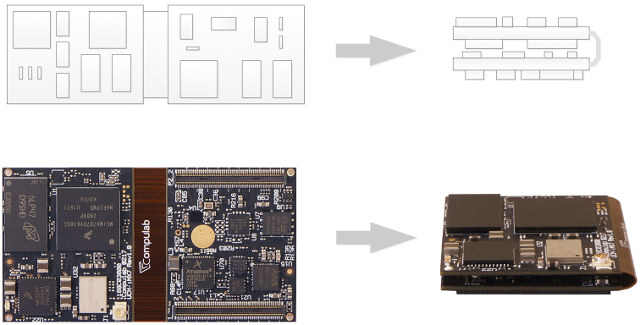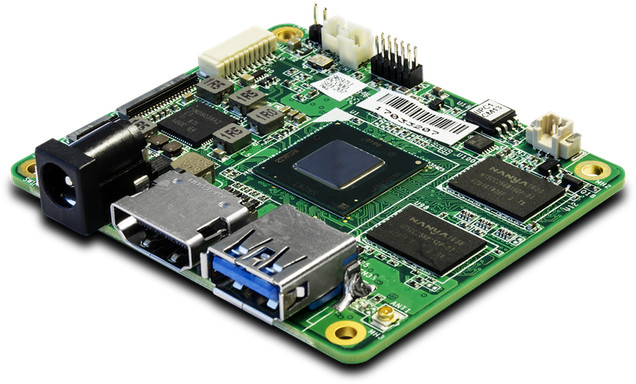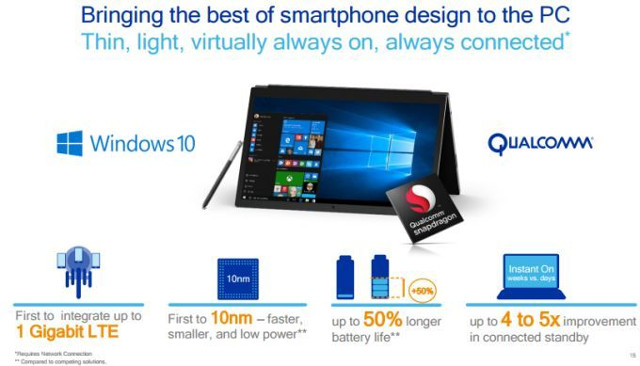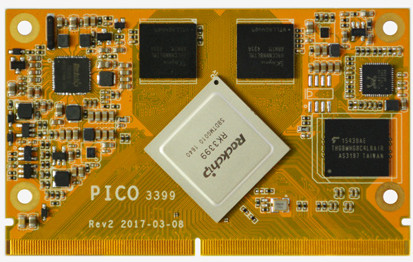When you think about visual programming on the Raspberry Pi or Arduino board, Scratch may come to mind, but some developers have decided to create their own visual programming language working for Arduino, Raspberry Pi, and other boards. Meet XOD, pronounced ksəud. The developers explains their used “functional reactive programming principles and added graphical functionality”. XOD is comprised of “nodes” that represents either some physical device like a sensor, motor, or relay, or some operation such as addition, comparison, or text concatenation, which you can link together through inputs and outputs to create a program, and XOD IDE will compile the resulting diagram to create and upload a binary program to Arduino, Raspberry Pi, etc… You can also convert a XOD diagram into a node with inputs and outputs to use it in another diagram, so the language is scalable. The developers are now looking for testers to play with […]
Compulab’s Miniature “Bend & Fold” UCM-iMX7 System-on-Module Could Fit into a Watch
Many companies are still releasing NXP – soon to be Qualcomm – i.MX 6/7 system-on-modules, but I don’t cover all of them, since we have already many to choose from. But Compulab’s latest UCM-iMX7 SoM differentiates itself by it size, using the company’s “Ultra-compact Multilevel Module” (UCMM) technology, to pack NXP i.MX7 processor, 2GB RAM, 64 GB eMMC flash, and a wireless module into a 30 x 27 x 8 mm volume that could potentially fit into something as small as a watch. The picture above clearly shows how UCMM technology works with the module comprised of two rigid PCBs and one flexible layer routing signals between the two allowing to bend and fold the rigid parts together to form a vertical stack. The principle could be extended to more PCBs and flexible layers, sof for example you could have four PCBs with three flexible layers in future / custom […]
UP Core Intel Board Has Launched for 69 Euros and Up on Kickstarter
During spring, we discovered UP Core, a tiny board powered by Intel x5-Z8350 Cherry Trail processor that promised to sell for as low as 69 Euros. But at the time, it was not available yet for purchase, and the good news is that UP has just launched a one month crowdfunding campaign on Kickstarter to raise funds for mass production, and promote the board. UP Core specifications have not changed since the first announcement: SoC – Intel Atom x5-Z8350 “Cherry Trail” quad core processor @ 1.44 GHz / 1.92 GHz (Burst frequency) with Intel HD 400 graphics @ 200 / 500 MHz System Memory – 1, 2 or 4 GB DDR3L-1600 Storage – 16, 32, or 64 GB eMMC flash, SPI flash ROM Video Output / Display – HDMI 1.4 port, full eDP (embedded DisplayPort) connector Audio I/O – Via HDMI, and I2S Connectivity – 802.11 b/g/n WiFi @ 2.4 […]
MediaTek MT7622 SoC with WiFi Network Accelerator Supports 4×4 802.11n WiFi & Bluetooth 5
MediaTek has launched a new ARM SoC for routers, home automation gateways, wireless audio and storage, with MT7622 equipped with a dual core ARM Cortex A53 processor, a dedicated network accelerator, 4×4 802.11n and Bluetooth 5 connectivity. Two models with be available: MT7622A with all features, and MT7622B with router features only, which probably mean no Bluetooth, and possibly less I/Os. MediaTek MT7622 specifications: Processor – Dual core ARM Cortex A53 @ up to 1.36 GHz Storage – eMMC and SDXC interfaces; storage accelerator (SATA 3.0/eSATA Gen2) Connectivity 802.11b/g/n WiFi @ 2.4GHz, 4T4R antenna; 802.11ac can be added through MT7615 SoC Bluetooth 5 Fast Ethernet Switch, RGMII and SGMII Network Accelerator – APT+HQoS, MediaTek Wi-Fi Warp Accelerator Audio – Audio Amplifier, I2S, TDM, S/PDIF USB – USB 2.0 host/device, USB 3.0 host Other Peripheral Interfaces – PCIe Gen 2.0, ADC, GPIO, I2C, IR, PMIC I/F, PWM, SPI, UART Misc – RTC The specs on the product […]
Windows 10 ARM Mobile PCs Demonstrated with Qualcomm Snapdragon 835 SoC at Computex 2017
Windows on ARM has been tried before with Windows RT, but the systems were crippled, and it was not exactly a success. Microsoft and Qualcomm are now giving it another try with ARM mobile computers running the full version Windows 10 on Qualcomm Snapdragon 835 processor, and Asus, HP, and Lenovo building devices based on the solution. There are plenty of inexpensive Intel PCs running Windows 10, so what would be the benefits of using Snapdragon 835 SoC? Qualcomm explains that it’s the first to coming integrate Gigabit LTE, it offers up to 50% longer battery life in specific use cases like watching videos and gaming, and thanks to big.LITTLE technology provides up to 4 to 5 times improvement in battery life compared to Intel’s solutions. Windows 10 does not have the same limitations as Windows RT had, and you can do pretty everything that you would on an Intel […]
Boardcon Introduces Rockchip RK3399 PICO3399 CPU Module and EM3399 Baseboard
There’s a limited number of boards based on Rockchip RK3399 processor, with the easiest to work with (for non-Chinese readers) probably being Firefly-RK3399. Shenzhen Xunlong is working on their own Orange Pi RK3399 board, 9Tripod released their X3399 SoM and devkit, Boardcon has also launched their own RK3399 SoM (system-on-module) and baseboard solution with respectively PICO3399 CPU module and EM3399 board. PICO3399 SoM specifications: SoC – Rockchip RK3399 hexa core processor with a dual ARM Cortex-A72 core cluster @ up to 2.0 GHz, quad ARM Cortex-A53 cluster, and ARM Mali-T860MP4 GPU System Memory – 4GB LPDDR3 Storage – 8GB eMMC flash 314-pin edge connector with 2x USB2.0 Host, 2x USB3.0 or 2x Type-C, UART, MIPI, GbE, HDMI in&out, Audio, I2C, I2S, PCI-E, SD/MMC/SDIO, GPIO, eDP.. Power Supply – 5V Dimensions – 82 x 50mm (8 layers) The company provides support for Android6.0.1 and Debian for the module. If the info […]
Infineon Claims to Have Implemented Post-Quantum Cryptography on a Contactless Security Chip
Today we protect systems, data, and communication using encryption keys of various lengths together with secure algorithms, and after a quick check, I found out banking websites are using 128-bit to 256-bit keys for secure (TLS v1.2) communication, and my Linux system is using a 4096-bit RSA key for secure communication over SSH. According to an Infineon press release, such key length are suitable for secure communication today, and current computer do not have sufficient processing power to break encryption, but with the advance of Quantum computer, even RSA-2048 keys won’t be secure, which means in 15 to 20 years all data encrypted (and stored) today with such keys would theoretically be accessible in the clear. That’s why the company has been working on next-generation post-quantum cryptography (PQC), and recently demonstrated the first PQC implementation on a commercially available contactless security chip, as used for electronic ID documents. The company […]
WebAssembly is a Cross-Platform, Cross-Browser Solution for High Performance Code in Web Browsers
Most code running in a web browser runs much slower than native code (C/C++/ assembly), and it’s fine for many applications, but some others requiring higher performance like software video decoding would have to relies on native code, initially provided via browser plugins, but then Google introduced PNaCL (Portable Native Client) allowing to run native code on multiple targets (ARM, Intel, etc..) but in Chrome browser only, and now one of Chrome developers has explained that the community has moved to WebAssembly. WebAssembly works just as well as PNaCl, and is already natively supported by Chrome and Firefox, with support added to preview versions of Microsoft Edge and Apple Safari browsers.Since it works just as well as PNaCL, and adoption of the later is low enough, Google decided to drop support for PNaCl in the Chrome browser in Q1 2018, except inside Chrome Apps and Extensions. To get a feel […]











